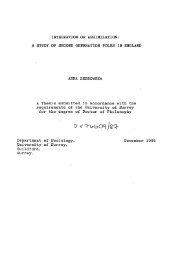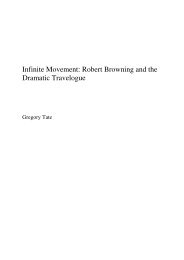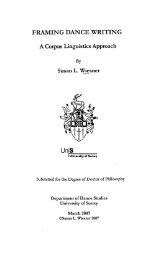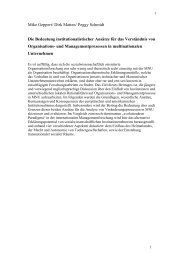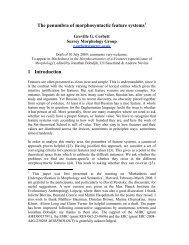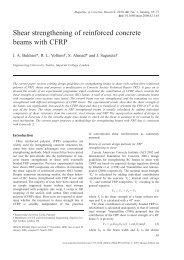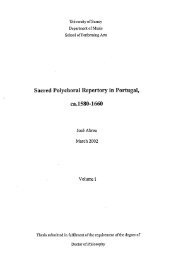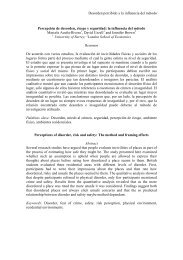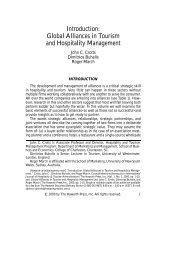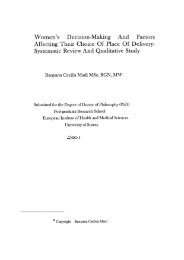Paper title - Surrey Research Insight Open Access - University of ...
Paper title - Surrey Research Insight Open Access - University of ...
Paper title - Surrey Research Insight Open Access - University of ...
You also want an ePaper? Increase the reach of your titles
YUMPU automatically turns print PDFs into web optimized ePapers that Google loves.
4 CONCLUSIONS<br />
A finite element analysis <strong>of</strong> a typical riveted railway bridge was carried out by traversing over<br />
the bridge the heaviest BS 5400 (1980) train. Damage in each connection was calculated using a<br />
two-slope S-N curve and Miner’s Rule. Comparisons between connections were made under an<br />
assumed two-class scheme (modified B and D). As expected, fatigue classification also alters<br />
the damage calculation.<br />
It was found that connection fixity affects considerably the stress histories and associated<br />
damage in the connections. However, overall, the fatigue ranking <strong>of</strong> the connections is not critically<br />
affected by the assumptions regarding fixity. The most critical connections, with only one<br />
track loaded, were identified as being the fully fixed stringer-to-cross-girder connections. More<br />
detailed investigation <strong>of</strong> these connections is currently under way.<br />
Table 3. Class B cross-girder-to-main girder damage.<br />
Fixed K K/40<br />
Connection Damage Connection Damage Connection Damage<br />
C4 3.19E-09 C8 6.88E-08 C8 8.01E-08<br />
C2 2.76E-09 C9 5.93E-08 C9 6.66E-08<br />
C3 2.68E-09 C3 5.00E-08 C3 6.62E-08<br />
C1 7.13E-10 C7 4.68E-08 C7 5.62E-08<br />
C7 5.64E-10 C4 4.09E-08 C4 5.41E-08<br />
C9 4.15E-10 C2 3.64E-08 C2 4.70E-08<br />
C8 1.26E-10 C5 2.41E-08 C5 2.50E-08<br />
C6 Compres. C6 1.51E-08 C10 1.93E-08<br />
C5 Compres. C10 1.28E-08 C1 1.61E-08<br />
C10 Compres. C1 1.01E-08 C6 1.26E-08<br />
Table 4. Class D cross-girder-to-main girder damage.<br />
Fixed K K/40<br />
Connection Damage Connection Damage Connection Damage<br />
C4 2.76E-09 C8 3.65E-08 C8 4.13E-08<br />
C2 2.43E-09 C9 3.22E-08 C9 3.54E-08<br />
C3 2.30E-09 C3 2.79E-08 C3 3.53E-08<br />
C1 8.58E-10 C7 2.68E-08 C7 3.09E-08<br />
C7 6.65E-10 C4 2.36E-08 C4 2.97E-08<br />
C9 5.14E-10 C2 2.16E-08 C2 2.66E-08<br />
C8 1.93E-10 C5 1.60E-08 C5 1.65E-08<br />
C6 Compres. C6 1.10E-08 C10 1.33E-08<br />
C5 Compres. C10 9.43E-09 C1 1.15E-08<br />
C10 Compres. C1 7.84E-09 C6 9.40E-09<br />
ACKNOWLEDGEMENTS<br />
The work described in this paper forms part <strong>of</strong> an ongoing project supported by EPSRC and<br />
Network Rail. The opinions expressed are those <strong>of</strong> the authors and do not necessarily represent<br />
those <strong>of</strong> the sponsors. We would like to thank Mr Brian Bell, Network Rail Project Officer, for<br />
valuable discussions and feedback on the paper.




